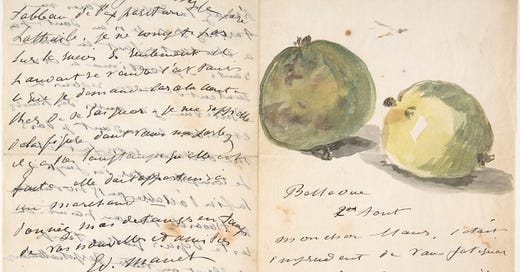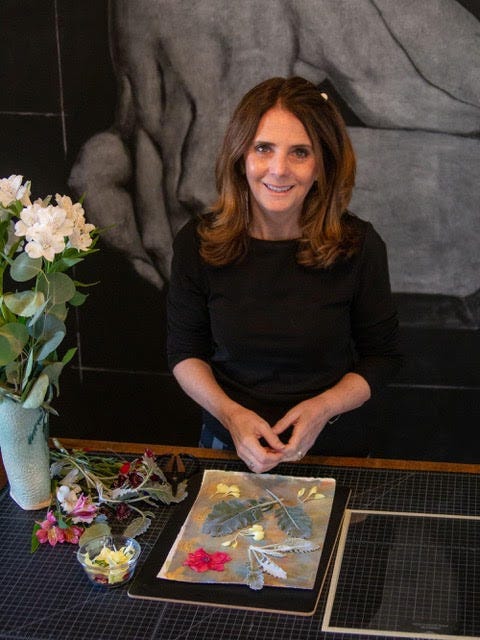Harbor your own dreams: An interview with Beth Kephart
“I experiment, I take risks, sometimes I pay more to make the things I love to make than I would ever receive in royalties or teaching fees.”
Editor’s note
Katrina Kenison describes Beth Kephart’s writing as suffused with “infectious passion and hard-won wisdom,” and Diana Abu-Jaber insists that Beth’s words “will linger with readers long after the final page.” Echoing their statements, a Kirkus review highlights the “rich vocabulary, lyricism, and careful word choices” that characterize Beth’s work.
Through my own encounters with her writing, I’ve found all of the above to be true. I immediately resonated with so much of what Beth shares in this melodic, deeply felt interview, and I’m thrilled that we get to share our exchange with so many others who I know will feel the same way.
Jana M. Perkins
Founder, Women of Letters
Beth Kephart, a National Book Award finalist, is the author, most recently, of My Life in Paper: Adventures in Ephemera (Temple University Press) and Consequential Truths: On Writing the Lived Life (Juncture Workshops). As the author of nearly forty books in multiple genres, Kephart has been named a winner of the Pew Fellowships in the Arts grant and a National Endowment for the Arts grant, among other honors. She has chaired national literature juries and has written about memoir and literature for the New York Times, the Washington Post, Creative Nonfiction, the Chicago Tribune, and elsewhere. Her books have received multiple starred reviews, been named to Best of Year lists, and been translated into more than fifteen languages. More at bethkephartbooks.com.
How did your childhood shape your ideas about what work looked like and what was possible for you?
Beth Kephart: This is such an interesting question — one I imagine I would answer differently every time I sat down to address it. This morning there is the fog of a long June rain as I write, and it is early, the near world asleep, so I am taken back to my father, an early riser, who worked enormously hard and endlessly to provide for his family of five.
I was his witness — up before dawn with him, often, sharing in his burnt-bread breakfast (plenty of sweet, rich honey butter spread across the top). We’d talk about the work he did as a man of spreadsheets and complex decision-making. We’d talk about whatever was pressing on me. He’d straighten his tie, pick up the briefcase, and roll away, down the driveway before the full sun was in the sky. He’d come home late. My childhood, then, was watching my father work hard for the family he loved; I believed, from the start, in hard work, in doing, always, more.
But my childhood was also shaped by my mother’s commitment to beautiful things — the cakes she baked and the dresses she sewed — and by my uncle’s great facility with paper. My uncle (my mother’s brother) made things — handmade cards, elaborate dioramas, Christmas ornaments. He invited me to make things with him. I loved being his assistant, our work spread out before us on a rickety card table.
Fast-forward to today. How did the path to what you’re doing now unfold?
BK: Need by need. Desire by desire.
I was never the most brilliant student in the classroom (hardly), but I worked extremely hard. I wasn’t entirely sure what one could do with my college degree in the History and Sociology of Science, but I forged a path — creating my own one-person consulting enterprise when I was twenty-five.
What I wanted — my desire — was to be a writer; it had been my dream since I was a child. But I understood from the very start that I would need a firm foundation beneath me before I could feel ‘safe’ writing, before I could allocate more than the rare stolen snatch of time to it. I’m a literary writer, after all, not a commercial entity. I experiment, I take risks, sometimes I pay more to make the things I love to make than I would ever receive in royalties or teaching fees.
Fortunately, I am married to an artist who began his career as a designer in small architectural firms and who has always shared my ideals regarding a modest lifestyle, a small, manageable home. As the years have gone on, we have tried to keep our living as simple and affordable as it can be, so that we each have more and more room to explore those pursuits — his art, my writing — that satisfy our souls.
Did you have any mentors along the way?
BK: I did not study writing at college and I do not have an MFA; in most ways I am an autodidact. But there were three times during which we turned our family vacation into a writing retreat for me — going to Spoleto to study with Rosellen Brown and Reginald Gibbons, going to Prague to study with Jayne Anne Phillips and William Gass, and going to Bread Loaf to spend more time with Jayne Anne. All of those people taught me important things about what writing is, and Rosellen and Jayne Anne remain friends.
“My childhood, then, was watching my father work hard for the family he loved; I believed, from the start, in hard work, in doing, always, more. But my childhood was also shaped by my mother’s commitment to beautiful things — the cakes she baked and the dresses she sewed.”
How would you describe what you do to a general audience?
BK: I spend time with language and story in pursuit of meaning. I help others who are on the same path.
What was one of the first big aha moments of your career?
BK: The first time I ever met a writer of any kind, I was a young mother, in my early thirties. I went to a bookstore to see Fae Myenne Ng, and I stood in line to talk with her. I have no recollection of giving her my address, but months later a package arrived in the mail; it was a pen from Fae Myenne, with encouragements to me. The aha moment was that I had been seen during a time that was, for me, marked by enormous invisibility.
What task(s) do you start your day with?
BK: I rise in the dark, just like my father did. I spend that time reading or writing. It is the deep think time of my day. After that, the day is a blend of teaching, manuscript review, the occasional corporate project, and bookmaking. Only in the dark hours do I do the work of generative writing.
Outside of your work, what’s something you feel you’ve thought about a lot more deeply than most other people?
BK: Well. Such an interesting question. I will say that I suppose I think a lot about the birds that come to my yard and the flowers I plant so that they will have seeds to eat. I’m also exceedingly engaged with world and political news, but I’m pretty sure I’m not alone in that obsession.
Tell us about a time when you had to take a big risk in order to move forward. What did that experience teach you about how to navigate difficult circumstances?
BK: There was a time — a long stretch — when I was working eighty-hour corporate consulting weeks so that I might pay off the mortgage and make certain our son would have the college tuition he would need and that sort of thing. I became brittle — depleted and sharp-edged. After many years, I made the decision to leave much of that work behind and to begin writing, instead, for magazines. It wasn’t easy financially. It was anything but certain. But I was no longer the person I wanted to be, and I knew that to save us, and to save me, I had to take that risk.
The lesson, for me, was that you must protect your own soul, you must still harbor your own dreams, in order to be the wife, mother, and friend you believe you were meant to be.
“I experiment, I take risks, sometimes I pay more to make the things I love to make than I would ever receive in royalties or teaching fees.”
What question(s) are you currently wrestling with?
BK: My own relevance. My own purpose. Primarily, in these years, I teach, then write, then work with paper to make those handmade books, cyanotype prints, marbled paper, etc. What will remain? What will matter in ten years, or twenty? Am I living inside time properly?
What book have you most often gifted to others?
BK: I have bought so many books through the years for friends and family, but each gift has been so specifically curated to the person, so there has not been a lot of overlap. When I teach, and when I write these many craft books on the making of memoir, I am urging readers toward dozens and dozens of authors and titles. Four writers I hope everyone can make the room to read: Michael Ondaatje, Marilynne Robinson, Alice McDermott, and Per Petterson.
What advice would you give to someone who was just starting out in your field?
BK: Write to expand your understanding of, and connection to, the world we live in; write to expand your understanding of, and connection to, yourself.
When you think of women who have inspired or influenced you, who comes to mind?
BK: My beloved grandmother died when I was nine. Her essence, her unfettered love for me, is always somewhere near.
Where do you feel the most scarcity in your life? Where do you feel the most abundance?
BK: Time. And love.
What keeps you going?
BK: My husband’s goodness. My son’s laugh. The conversations I have with those I love. The birds and the flowers in the garden.
“It wasn’t easy financially. It was anything but certain. But I was no longer the person I wanted to be, and I knew that to save us, and to save me, I had to take that risk.”
How do you show kindness to the people you care about?
BK: This is, in fact, my greatest concern. I try to do this in a myriad of ways. Making the home beautiful. Cooking favorite dishes. Finding or making the right gift. Staying in touch. Asking How are you? and truly caring about the answer.
What kind of legacy do you hope to leave?
BK: As a teacher, I am committed to helping writers find not just their stories, but themselves.
As a writer, I am committed to finding new ways to tell unexpected stories, new ways of making writing new to myself.
As a wife, mother, and friend, I am committed to being near — through the tumult and the joy.
Is there a project, initiative, or cause you’d like to highlight?
BK: Voting matters. Our futures depend on it.
Where can our readers find you?
BK: My writing life is presented at bethkephartbooks.com.
My teaching life is presented at junctureworkshops.com.
My book art is presented at bind-arts.com.
We corresponded with Beth over email in June. The text of our exchange has been edited for clarity.
Thanks for being here! We’re delighted that you’re a part of the Women of Letters community. If you are too, here are a few ways you can help build it:
❤️ Heart this interview and leave a comment.
💌 Recommend our series with a testimonial. We’ll feature our favourites on the home page.
💬 Forward your favourite interviews to the people you care about, or share a link to womenofletters.substack.com.






